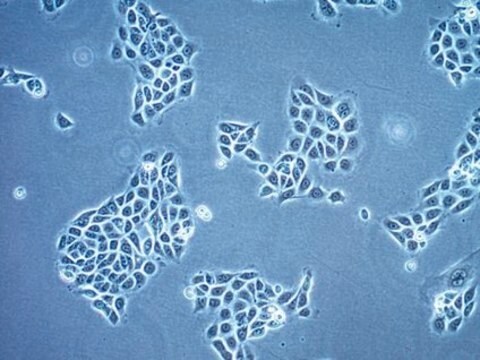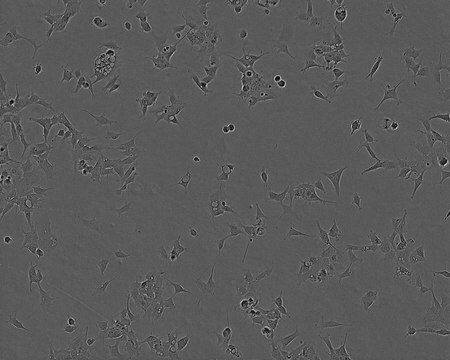SCC160
CFBE41o- 6.2 WT-CFTR Human CF Bronchial Epithelial Cell Line
Human
Sinonimo/i:
CFBE41o, CF41o, CFBE
About This Item
Prodotti consigliati
Nome del prodotto
CFBE41o- 6.2 WT-CFTR Human CF Bronchial Epithelial Cell Line, CFBE41o- 6.2 WT-CFTR human CF bronchial epithelial cell line is used to study the relationship between CFTR mRNA expression and Cl transport function.
Origine biologica
human
tecniche
cell based assay: suitable
cell culture | mammalian: suitable
Condizioni di spedizione
ambient
Descrizione generale
CFBE41o- 6.2 WT-CFTR Human CF Bronchial Epithelial Cell line is a subclone derived from the electroporation of the parental CFBE41o- cell line with an Epstein-Barr virus (EBV)-based episomal pCEP4β vector containing the 6.2 kb full length wtCFTR cDNA and a Hygromycin B resistance gene . The 6.2kb wtCFTR cDNA contains both the 5’ and 3’ UTR sequences that are known to affect translational efficiency and mRNA stability. The parental CFBE41o- is a CF human bronchial epithelial cell line, derived from a CF patient homozygous for the ΔF508 CFTR mutation and immortalized with the origin-of-replication defective SV40 plasmid (pSVori-) .
In CFBE41o- 6.2 WT-CFTR cells, the levels of vector-driven wt-CFTR mRNA were found to be significantly higher than endogenous CFTR mRNA levels in normal 16HBE14o- bronchial epithelial cell (Cat. No. SCC150). However, cAMP-dependent Cl currents generated in CFBE41o- 6.2 WT-CFTR cells were not as high as those observed in 16HBE14o- cells, which express endogenous CFTR. Established CF bronchial epithelial cell lines that are complemented with either wild-type or ΔF508CFTR mRNA would help provide insights into the relationship between transgene-derived CFTR mRNA expression and rescue of cAMP-dependent Cl transport function.
Descrizione della linea cellulare
Applicazioni
Qualità
• Cells are tested by PCR and are negative for HPV-16, HPV-18, Hepatitis A, C, and HIV-1 & 2 viruses as assessed by a Human Essential CLEAR panel by Charles River Animal Diagnostic Services.
• Cells are negative for mycoplasma contamination.
• Each lot of cells is genotyped by STR analysis to verify the unique identity of the cell line.
Stoccaggio e stabilità
Esclusione di responsabilità
Unless otherwise stated in our catalog or other company documentation accompanying the product(s), our products are intended for research use only and are not to be used for any other purpose, which includes but is not limited to, unauthorized commercial uses, in vitro diagnostic uses, ex vivo or in vivo therapeutic uses or any type of consumption or application to humans or animals.
Codice della classe di stoccaggio
10 - Combustible liquids
Classe di pericolosità dell'acqua (WGK)
WGK 1
Punto d’infiammabilità (°F)
Not applicable
Punto d’infiammabilità (°C)
Not applicable
Certificati d'analisi (COA)
Cerca il Certificati d'analisi (COA) digitando il numero di lotto/batch corrispondente. I numeri di lotto o di batch sono stampati sull'etichetta dei prodotti dopo la parola ‘Lotto’ o ‘Batch’.
Possiedi già questo prodotto?
I documenti relativi ai prodotti acquistati recentemente sono disponibili nell’Archivio dei documenti.
Articoli
16HBE14o- human bronchial epithelial cells used to model respiratory epithelium for the research of cystic fibrosis, viral pulmonary pathology (SARS-CoV), asthma, COPD, effects of smoking and air pollution. See over 5k publications.
Il team dei nostri ricercatori vanta grande esperienza in tutte le aree della ricerca quali Life Science, scienza dei materiali, sintesi chimica, cromatografia, discipline analitiche, ecc..
Contatta l'Assistenza Tecnica.








